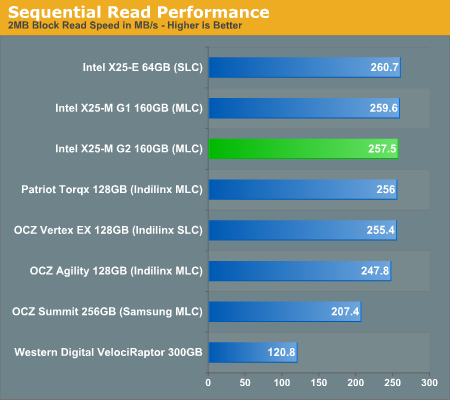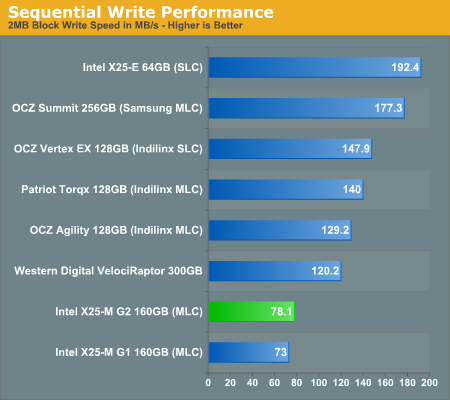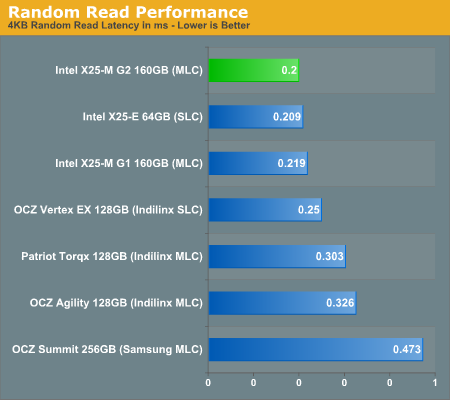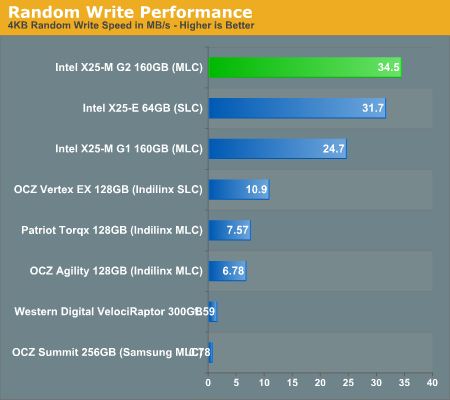Intel X25-M G2: Dissected and Performance Preview
by Anand Lal Shimpi on July 22, 2009 6:00 PM EST- Posted in
- Storage
The Performance
There are four basic pillars to SSD performance that I like to look at: random read, random write, sequential read and sequential write speed. A good SSD must be strong in all four categories, but some are more noticeable than others. Random read and write speed, particularly of small files (e.g. 4KB) are normally what make our desktop hard drives feel so slow. These random operations are everything from file and table updates to search queries and loading applications; they aren't random over the entire space of the disk but they are random enough to bring conventional hard drives to their knees.
Sequential read/write speed is what you encounter when copying large files. How quickly you can move a Blu-ray image around is determined by these values. I've run all four tests on these drives using IOMeter. I also test all SSDs in a completely used scenario where each LBA/page has been touched, at some point, with valid data. Brand new, out of the box, performance will be greater but not over the life of the drive. If you want to know more about why this is and how I test, I suggest consulting The SSD Anthology.

Sequential read performance is basically maxed out for these drives; we're bottlenecked by the SATA bus at this point (300MB/s minus some overhead). We won't see sequential read performance improve until the 6Gbps SATA protocol starts appearing in controllers. The X25-M G2 is basically the same speed as the previous gen here.

Sequential write performance has always been a bottleneck on the Intel drives. There's a small 7% performance improvement from the new drive, but it's still much slower than any other MLC drive in its class. Pushing higher speeds isn't an issue for the controller as the SLC X25-E actually posts our fastest numbers here.
While I don't believe that 70MB/s write speeds are terrible, Intel does need to think about improving performance here because the competition is already far better. The more important values are still random read/write performance, but sequential write speed is an area that Intel continues to lag behind in.

The real strength of the Intel drives is in its random, small file, read/write performance. Here we see a 10% improvement in random read performance over the 1st gen drives, putting the new X25-M ahead of even the X25-E. Now there are obvious lifespan benefits you get from an SLC drive that the G2 can't match, but for a desktop user this thing is even better than the X25-E.
None of the competitors can touch the X25-M here; Intel is 50% faster than the closest MLC contender. It's tough to read but the WD VelociRaptor scores a 0.68MB/s score here.

These are the same results as above but I'm reporting average latency instead of average transfer rate. It gives you a bit of the idea of the scale of performance here. I had to remove the WD VelociRaptor because its read latency threw the chart's scale off, it averaged 17.3 ms here.

And the X25-M G2's true strength: random write performance. Once again, we're faster than the X25-E and nearly 40% faster than the X25-M G1. None of the Indilinx or Samsung drives can touch Intel here.
The Samsung RBB controller does not seem to like worst-case random writes on a well used drive, it's actually slower than the VelociRaptor here. This is what I've seen in my earlier investigations as well. It actually helps explain why the older Samsung based SSDs in Apple notebooks never really felt all that fast.
Final Words...for now
The X25-M G2 appears to be everything Intel said it would be. It's anywhere from 0 - 40% faster than the 1st gen drive in these low level tests. I would expect to see a 0 - 10% improvement in the real world depending on applications, but that's what I'm off to test next.










87 Comments
View All Comments
Robear - Thursday, July 23, 2009 - link
Thanks for the quick update. I'm on the edge of my seat with these new drives. The suspense reminds me of when Conroe first debuted ;)Given the apparent quality of the controller, I'd like to assume that the low sequential writes were intentional to some degree. I'm sure Intel's engineers had to make some design decisions, and it appears as if they've chosen to sacrifice sequential writes in most (if not all) cases in favor of random writes.
I think Intel is on the right track with the controllers on these drives. If you look at desktop usage patterns, your random reads / writes reign supreme. Sequential writes are the most infrequent operations.
Anyway, that's based on the assumption that random write performance and sequential write performance are mutually exclusive somehow (supported by the X-25E benches...).
VERY interesting.
I'm also very interested to see how interfaces and controllers try to keep up with the drastic increase in storage bandwidth for the enterprise. The current mass storage architecture is mature and versatile. Going straight PCI-E seems to be a step backwards in architecture in exchange for raw performance. It seems to me to be an immediate stop-gap, and I'm not sure how many serious companies will buy into this fusion-IO thing long-term.
I'd personally rather have 7 SLC's in a RAID 5EE over two redundant PCI-E cards and one hot-spare. It's far more cost efficient, and I think everyone will agree hot-swapping SAS/SATA is a lot easier than hot-swapping an internal card.
All and all, very exciting.
glugglug - Thursday, July 23, 2009 - link
PCI-E Will be even be an even shorter term stop gap than most people realize.PCI-E x1 bandwidth is the same as regular PCI: 133MBps.
So PCI-E x4 like the Fusion I/O uses is actually slightly below the SATA 3.0 600MBps spec that will be out soon.
glugglug - Thursday, July 23, 2009 - link
Actually I just looked this up, its rated higher than I thought, especially since they doubled it with PCI-express 2.0.2.0 is 500MB/s per lane, so theoretically the PCI-e 4x cards could get up to 2GB/s
Still with the rate these things are improving I think that is 2 years away.
iwodo - Thursday, July 23, 2009 - link
You really dont need 4x Slot. PCI - E 2.0 2x Slot already gives you 1GB/sSince PCI-E Express 3.0 is coming at 1GB/s single Slot. I think 2x for compatibility is reasonable enough.
araczynski - Thursday, July 23, 2009 - link
...this is basically saying the drives are great (assuming the price is much better than the X25-E) as long as you're not moving large files around?i.e. the relatively infrequent software installations wouldn't be optimal, but otherwise it would be quite a good drive? or like an OS drive basically?
can you throw in an average 7200 rpm hard drive into the mix for a relative comparison?
araczynski - Thursday, July 23, 2009 - link
ooops, never mind, forgot about the velociraptor in there :)bobsmith1492 - Thursday, July 23, 2009 - link
Perhaps a log scale would be appropriate to show the orders of magnitude in difference between the drives!iwodo - Thursday, July 23, 2009 - link
The 64Gb 8Gx8 MLC cost average 12.5. Ofcoz since Intel are making the Flash themselves ( or Joint Venture ) they are already making a profit on Flash. 10 of those = 125. I think controller may be a 90nm tech cost around $15. Again Intel is making profit on the controller as well. Packaging and DRAM etc, the 80GB SSD should cost $160 to make.I believe that NAND price is still based on 50NM - 40NM price. So 34nm should cost less. Hopefully in a years time it will cost 50% less.
In 2010, SSD should finally take off.
KenAF - Thursday, July 23, 2009 - link
Has Intel committed to supporting TRIM with a firmware update on G2?smjohns - Thursday, July 23, 2009 - link
Yeah Intel have confirmed that TRIM support will be delivered as part of a firmware upgrade to be released when Windows7 supports this. Apparently for XP & Vista machines this will also require supporting software to be installed as neither have inbuilt TRIM functionality.Not so good news for the original G1 drives as it does not seem that Intel will be releasing similar firmware for these.